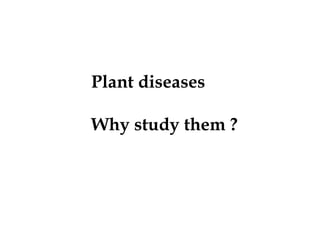
Plant microbe interaction class 1.pptx
- 1. Plant diseases Why study them ?
- 2. Sustaining sufficient agricultural production to feed the world while preserving a clean, safe and a healthy environment for the very people we are trying to feed.
- 3. • About 3000 plants are used by humans as food source • 30 plant species make up 90% of our food supply • Plants provide feed for animals • Lumber for shelter, furniture • Fibre for cloth, fabrics, rope and paper • Medicine, beverages, chocolates • Aesthetic appeal, relaxation and recreation
- 4. Plant Diseases – yield loss- famine Bacterial wilt Chestnut blight Coffee rust Downy mildew Ergot of rye Phytophthora root rot Potato late blight Rice blast Root Knot Smuts of cereals Rusts of wheat Tobacco mosaic
- 7. British rule : 85 million deaths due to famines.
- 10. What is a plant disease? •Visible effects of disease on plants are called symptoms. Any detectable changes in color, shape, and/or functions of the plant in response to a pathogen or disease-causing agent is a symptom. •Signs of plant disease are physical evidence of the pathogen, for example, fungal fruiting bodies, bacterial ooze, or nematode cysts. Signs also can help with plant disease identification
- 11. What causes Plant Disease a. Micro organisms and parasitic Plants b. Environmental factors, faulty nutrition, chemical substance
- 13. Identifying the agent of a Plant Disease Kochs Postulates a. Consistent association with disease b. Isolated in pure culture/abiotic agent identified c. Healthy plants inoculated with pure culture of pathogen / treated with abiotic agents/ conditions should develop same symptoms d. Same pathogen/ agent must be isolated or identified
- 14. • Atmospheric CO2 concentration has increased from 280 p.p.m. in 1750 to 368 p.p.m. in 2000 • Temperature is projected to increase by 3·4°C and CO2 concentration to increase to 1250 p.p.m. by ∼2095
- 15. Climate change, plant diseases and food security: an overview Plant Pathology Volume 60, Issue 1, pages 2-14, 10 JAN 2011 DOI: 10.1111/j.1365-3059.2010.02411.x http://onlinelibrary.wiley.com/doi/10.1111/j.1365-3059.2010.02411.x/full#f1
- 16. Plant Virus 700 known plant viruses Barley yellow dwarf virus- 150 spp .of poaceae 15-38% reduction in yield Cassava mosaic- UgV recombinant strain of ACMV and EACMV •Transmitted by insects which are called vectors
- 18. Genome of BYDV
- 19. Plant Bacteria Xanthomonas 350 different plants Basmati rice is highly susceptible to bacterial blight Bacterial blight of rice Bacterial blight of banana Ralstonia solanacearum ; infects 200 different plants Bacterial wilt of ginger Bacterial wilt of chilli
- 21. PXO99A KACC MAFF Length (bp) 5,240,075 4,941,439 4,940,217 GC content (%) 63.6 63.7 63.7 Annotated genes 5,083 4,637 4,372 IS elements (complete/fra gment) 267 (683) 252 (714) 251 (712) TAL effector genes 19 15 17
- 23. Plant Nematodes
- 26. Secondary cycles •Some diseases have only one cycle during the growing season (often root rots) •Some diseases develop secondary or repeating cycles during the growing season (often foliar diseases) •Number of cycles depends on the pathogen, susceptibility of the host, and environmental conditions
- 27. Summary •Understanding the difference between a sign and a symptom is key in identifying a plant disease •A plant disease cannot develop if a susceptible host, pathogen, and favorable environment do not occur simultaneously •The major plant pathogens responsible for disease development in plants are fungi, bacteria, viruses, and nematodes •The disease cycle describes the interaction of the pathogen with the host